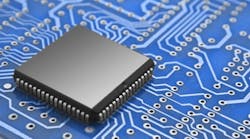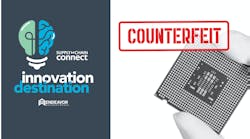The war against counterfeit electronic components continues, and suppliers large and small are stepping up to help customers avoid turning to unauthorized sources of parts—a practice that leaves original equipment manufacturers (OEMs) vulnerable to bogus parts entering their supply chains. Today, distributors in particular are developing new and innovative business models designed to help customers avoid the open market and ensure a long-term supply of critical components, especially when it comes to end-of-life and obsolete parts.
Area 51 Authorized, a distributor based in Irvine, Calif., began offering special long-term purchasing programs for end-of-life (EOL) parts about five years ago. Interest in the programs has accelerated in the last two years as component manufacturers have sped up their EOL programs on many parts. Area 51 president Steve Shammah explains that economic obstacles are making it increasingly difficult for component manufacturers to carry the breadth of products customers require.
“Their catalogs are just too broad. They can’t continue to have the offering they do when financially it’s not practical, or the user base is not what it was, or new technology emerges,” Shammah says. “[The problem is], that doesn’t stop the needs of OEMs with products in the field.”
Many OEMs plan to have products in the field for 10 or more years, but they don’t have the capital to purchase and stock the components required to build them for that long.
“Someone has to buffer that. And we’ve found an incredible niche in that very area,” Shammah explains. “For every part that goes EOL, it’s a new beginning of life for Area 51.”
Area 51 offers a fee-based service in which the distributor funds long-term stocking programs for customers. If a customer needs a part that is going EOL, Area 51 will buy as much as the customer needs from the manufacturer, stock it, and schedule just-in-time delivery of the items. Shammah says Area 51 Authorized purchases only from authorized sources and maintains proper storage and handling certifications to ensure product quality. What’s more, the inventory is reserved solely for that particular customer.
“I think the primary concern of OEMs we’ve been talking with [is that] they don’t want to put up the capital that’s required to fund a 12-year stocking package—and no mainline distributor wants to schedule more than three years out,” he says. “We find the gap that we provide fulfills the lifespan of the OEMs’ product.”
Shammah admits it’s not easy to fund such programs, especially for smaller distributors with limited access to capital. Such programs can require millions of dollars in upfront costs, he says, but they also ensure long-term business for the distributor.
“We recognize the business we could capture, and if you capture enough of it, then you’re building business that can ship every month for the next 10 years, giving you a foundation to grow on,” he says. “[This program] gives us a backlog [of business] that our bank likes to see. It really gives us a strong backbone to build in business that is 10 years forward.”
The Anti-Counterfeit Angle
Programs such as Area 51’s offer a response to customers’ growing concerns over counterfeit components, Shammah explains. Since last year’s passage of the National Defense Authorization Act (NDAA), more customers are seeking proof that suppliers can verify the authenticity of the components they sell—an issue that becomes more acute when customers can’t find the components they need and start turning to open-market sources. The NDAA includes new rules for purchasing electronic components in the defense supply chain, heightening awareness among customers in virtually all lines of trade to the dangers of counterfeit components.
Even large authorized distributors are finding themselves needing to prove the authenticity of their inventory. Kevin Sink, vice president of total quality for authorized distributor TTI Inc., said earlier this fall he was seeing an increase in weekly requests from customers seeking counterfeit mitigation plan statements. Such actions are a response to the NDAA’s Section 818, which addresses the need for enhanced inspection and reporting procedures among government agencies and contractors.
Companies throughout the supply chain say there’s good reason for the concern. The danger of counterfeit parts includes product failure—in the worst cases, causing injury or even death and in others contributing to a reputation for poor quality. In a recent webcast sponsored by industry analyst firm IHS, NASA representatives identified counterfeiting as one of their greatest concerns.
“Our number one challenge is counterfeit parts,” said NASA’s Steven Foster, head of procurement quality assurance at the Dryden Flight Research Center, adding that the situation causes the agency to engage in extensive activities to mitigate risk.
Electronics distributor Components Direct offers another pointed example of a company attempting to combat the counterfeit problem by offering customers access to authentic obsolete and EOL parts. The company offers 100% traceable semiconductor components from more than 150 manufacturers and bills itself as the premier source for excess and EOL semiconductors.
“As lifecycles for components become shorter, manufacturers are seeking new distribution channels that enable them to meet the demand for end-of-life parts while they focus their own sales efforts on newer technologies,” the company said in a statement announcing its new online search engine, componentsdirect.com, launched in June to provide a one-stop online shop for excess and EOL parts. Components Direct functions as an extension of the manufacturer, stocking parts that OEMs still need, but manufacturers don’t want to keep on the shelves.
“Components Direct ensures that engineers and supply chain professionals now have a trusted, one-stop shop for all their excess and end-of-life components needs,” Tom Lacey, the distributor’s chairman and CEO, said in announcing the new service earlier this year. “Our direct relationship with manufacturers enables us to provide a reliable online distribution source for authentic, manufacturer-original semiconductor components.”
Such sources are likely to gain prominence among customers making everything from fighter jets to toasters as the fight against counterfeits keeps going. Defense agencies continue to look for new ways to keep counterfeits out of their supply chains in accordance with NDAA requirements. This fall, the Defense Logistics Agency announced that it will require DNA marking on certain electronic microcircuits, for example, and said in late October that it will continue to identify other marking methods.
“OEMs are certainly taking this more seriously now,” Shammah says of counterfeiting and the need to be more vigilant in your purchasing process. “Beyond the military, people are reading about it and saying ‘we’d better think about this issue.’ They may not have had these types of concerns in the past, but they’re very concerned now.”








